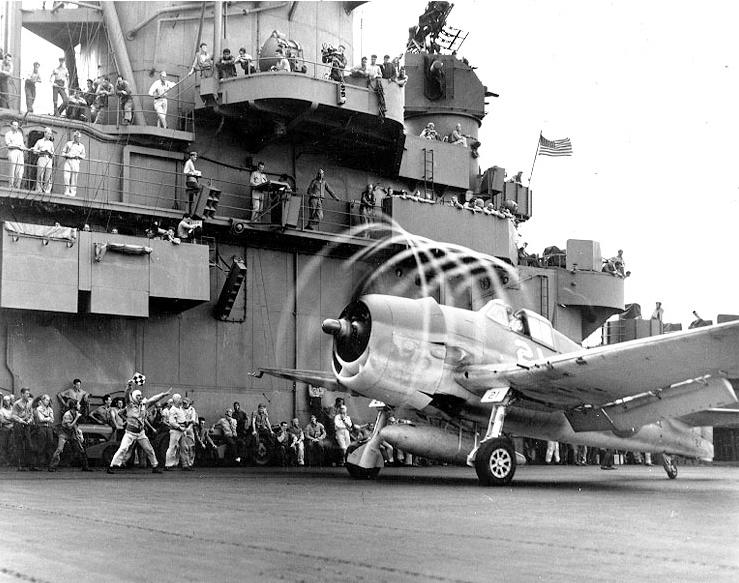" The Hellcat won the Pacific air war. Period. It destroyed Japanese aviation and made our victory inevitable."
-- Cpt. David McCambell, Amertican Hellcat ace, U.S. Navy Symposium on Pacific War Aviation, 1962
Superficially the F6F Hellcat looks much like the Wildcat. Perhaps because of this and its very plain lines, the Hellcat is not as instantly recognizable and sometimes does not get the credit it deserves. It capabilities were night and day removed from that of the plane it replaced. The Hellcat had been on the drawing boards at Grumman before Pearl Harbor. The Navy did not know, however, how badly the Wildcat was outclassed by the Japanese Zero. This soon became apparent and Grumman rushed the Hellcat development forward. Leroy Grumman, and his two top engineers, Leon Swirbul and Bill Schwendler, worked on the Hellcat. It soon established itself as the Navy's carrier-based fighter answer to the Zero. The Navy had to, however, to fight the Zeros with Wildcats during 1942 and some of 1943. And some Marine air groups did not even have Wildcats. The Marines on Midway had the badly out-classed Brewster Buffalo already phasedout by the Navy. The Hellcats at first shocked the Japanese pilots who were used to the sluggish performance of the under-powered Wildcats. The young Japanse pilots perhaps can be forgiven for thinking that the War would be fought out with the planes, ships, and other arms possessed in 1941. The Japanese High Command who launched the War should have realized that Pearl Harbor would unleash a previouly teathered industrial behemoth that would not only spew out arms in incredadable volume, but of constantly improving quality.
The Hellcat was much larger than the Wildcat and far more capable. It had higher performance, a larger fuel tnk and thus greater range, and a larger ammunition load. Huge wings gave it unprecedented maneuverability.
The Hellcat soon became known as the 'Ace maker'. Radial engines meant it did not have the sleek appearance of some fighters and it was also called the 'Aluminum Tank'. Its six Browning .50 caliber machine guns gave it massive fire power. And the Hellcat could absorb hits and still allow the pilot to get back to his carrier. Grumman itself became known as the Grumman Iron Works. The Hellcat in the hands of even a relatively inexperienced pilot was an effective weapon, in the hands of an experienced flier it was a formidable weapon that savaged poorly armored Japanese aircraft, including the widely feared Zero. The Hellcat became the Navy's front-line fighter for the new Essex-class carriers that began reaching the Pacific Fleet (1943). The Hellcat and the Essex-class carriers gave the Navy air dominance as it began the drive west in the Central Pacific. The pilots loved it as it handled so well and had a powerful engine to engage the Japanese. Navy a
air ace, Eugene Valencia. who flew Hellcats staring at Tarawa, stated, "I love this airplane so much, that if it could cook, I'd marry it." The capabilities of the Hellcat and the steady loss of experienced Japnese air crews resulted in phenomenal kill rates throughout the remainder of the Pacific War.
CIH--WWII

Navigate the CIH World War II Section:
[Return to Main World War II fighter page]
[Return to Main World War II air weapns fixed-wing types page]
[Return to Main World War II air weapon types page]
[Return to Main World War II air weapons page]
[Return to Main World War II air technology/tactics page]
[Return to Main World War II technology/tactics page]
[Biographies]
[Campaigns]
[Children]
[Countries]
[Deciding factors]
[Diplomacy]
[Geo-political crisis]
[Economics]
[Home front]
[Intelligence]
[Resistance]
[Race]
[Refugees]
[Technology]
[Bibliographies]
[Contributions]
[FAQs]
[Images]
[Links]
[Registration]
[Tools]
[Return to Main World War II page]
[Return to Main war essay page]
Created: 6:12 PM 2/14/2014
Last updated: 12:50 AM 2/15/2014



